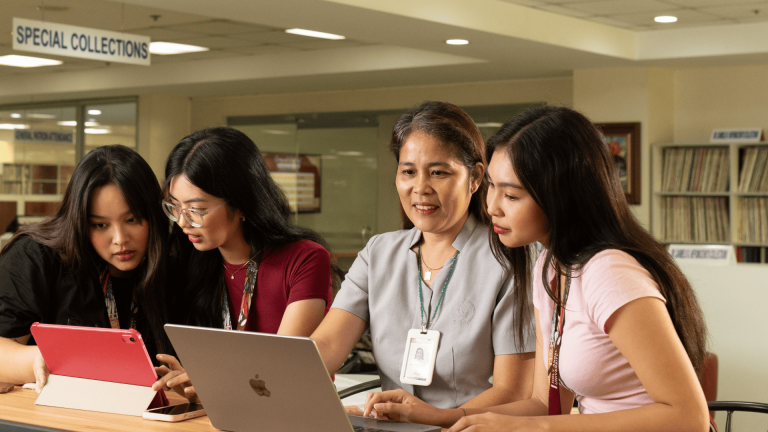
Understanding the mobile learning experience
Mobile learning is more than a buzzy phrase. It's transforming the educational landscape globally. But what exactly is it, and how is it reimagining education?
Often shortened to mLearning, mobile learning is a digital education model where learning materials are accessed via mobile devices, such as tablets and smartphones. This technology-enhanced learning also often allows students to engage in and complete educational activities on their mobile devices.
Instead of teaching being confined to a physical classroom, mobile education enables teaching to take place anywhere. And when asynchronous mobile learning units are employed, teaching and learning can also take place at any time, without anyone having to work outside their normal work hours.
This shift towards mLearning doesn't just offer flexibility, it revolutionises the way we perceive education. It breaks down geographical and temporal barriers, fostering an inclusive learning environment where every student has an equal chance to learn and excel. Because a mobile learning experience can be personalised to suit each individual learner's pace and preferences, it's truly a game-changer.
Because education isn't a one-size-fits-all affair—at least it shouldn't be. Everyone has different learning styles, capacities, and needs. Modern, best-in-class educational strategies acknowledge these differences. Mobile learning experiences, in conjunction with personalised learning and competency-based education, are another tool that educators can use to help tailor their instruction accordingly.
The result is a mobile learning centre that nurtures motivated, engaged learners who take an active role in their own education.
Reaping the rewards of mobile education
The benefits of mobile learning are as diverse. The first is flexibility. The ability to learn on the move and in any location—whether on a commute, while waiting for an appointment, or at home fitting study in around a child's nap times—offers a convenience that traditional classroom learning cannot match. Mobile education technology empowers learners, allowing them to absorb knowledge at their own pace and on their own terms.
This flexibility is also great for teachers. Instead of being restricted to cramming quality education into classroom time, teachers can prepare additional materials for students to consume out of class. This is especially useful when some students take longer to grasp concepts. Educators can prepare personalised materials targeted at the gaps in each student's understanding and deliver them on-demand, outside of standard classroom time.
Mobile learning also brings with it a variety of online learning platforms, which offer a unique set of tools and interfaces to enhance learning experiences. The best of these platforms allow for customised interactive content that caters to individual learning styles and keeps learners engaged, leading to better information retention and overall understanding.
Access is another significant advantage of mobile learning. In regions where traditional classroom access might be limited, mobile learning fills in the gaps. It democratises education, ensuring that every learner, regardless of their geographical location or personal circumstances, has a fair shot at learning.
Mobile learning is also cost-effective. It eliminates the need for physical infrastructure, transportation, and print materials. This makes education more affordable and sustainable, both for institutions and learners.
Lastly, mLearning promotes collaboration. Despite physical distance, students can participate in group projects, engage in real-time discussions, and interact with their peers and teachers just like they would in a physical classroom. This fosters a sense of community and builds vital communication skills, making learning a more social and interactive experience.
Canvas: Powering your mobile learning experiences
But how can you turn mobile learning’s benefits into a reality? Enter the Instructure learning platform.
We've always been at the forefront of educational technology, and the tools we've created to facilitate a quality, engaging mobile learning experience are no exception. Through our Canvas learning management system (LMS), we're bridging the gap between digital potential and real-world learning success.
Canvas is a versatile, user-friendly LMS that prioritises the needs of both educators and learners. It goes beyond simply adapting the classroom experience to mobile devices. Instead, it offers a dynamic and interactive learning environment that fosters motivation and engagement.
Canvas isn’t just about content delivery. It's about fostering collaboration, nurturing engagement, and personalising the learning experience. With features that allow for real-time interaction between teachers and students, dynamic multimedia content, and adaptable learning paths, Canvas takes mLearning to the next level. And with handy integrations, like the Nearpod integration that enables educators to deliver engaging virtual reality and augmented reality lessons, Canvas can truly revolutionise anyone's teaching.
Canvas's easy-to-navigate interface makes it an ideal platform for teachers to organise their lessons and track students' progress, offering a myriad of tools to make learning efficient and effective. Because it’s cloud-based, Canvas allows for seamless updates, ensuring educational content is always current and relevant.
There's also a dedicated mobile app that's fully optimised for smartphones to provide the best mobile learning experience, including an offline mode that allows users to download course content when they have internet access and then automatically sync upon reconnection.
Mastering the challenges of creating a dynamic mobile learning hub
Every innovation has its challenges, and mobile learning is no exception. Understanding these hurdles is the first step to addressing them.
One key challenge in mobile learning is the digital divide. Not every student has access to the necessary technology for mLearning, creating an unequal education landscape. In addition, some areas may suffer from weak or unstable internet connections, hampering the learning experience.
Educational institutions might also face issues with training teachers to effectively use mobile learning platforms. Adapting to new technology can be daunting for educators accustomed to traditional teaching methods.
Instructure plays a crucial role in addressing these challenges. We’re committed to making our platform as accessible as possible, working with schools and communities to ensure all students can access mobile learning, including enabling students to work in offline mode.
We also offer comprehensive support and training for educators. Our aim is to empower teachers, equipping them with the knowledge and skills they need to confidently navigate and use our platform. We understand technology is only as powerful as the people who use it, and we're here to ensure all educators wanting to use Canvas are well-equipped for the journey.
Related Content
 meet-canvas-apac-team-christopher.png
meet-canvas-apac-team-christopher.pngBlogs
 philippines_ched_cmo.png
philippines_ched_cmo.pngBlogs
 meet-canvas-apac-team-avi.png
meet-canvas-apac-team-avi.pngBlogs